This post may contain affiliate links. Please see our disclosure policy.
A must-have addition to any cheese plate or charcuterie board, the bright flavor of quince paste is easy to achieve at home using only a handful of ingredients. Known as Membrillo in Spain, Marmelada in Portugal, and Cotognata in Italy, this homemade quince paste recipe is the same worldwide.
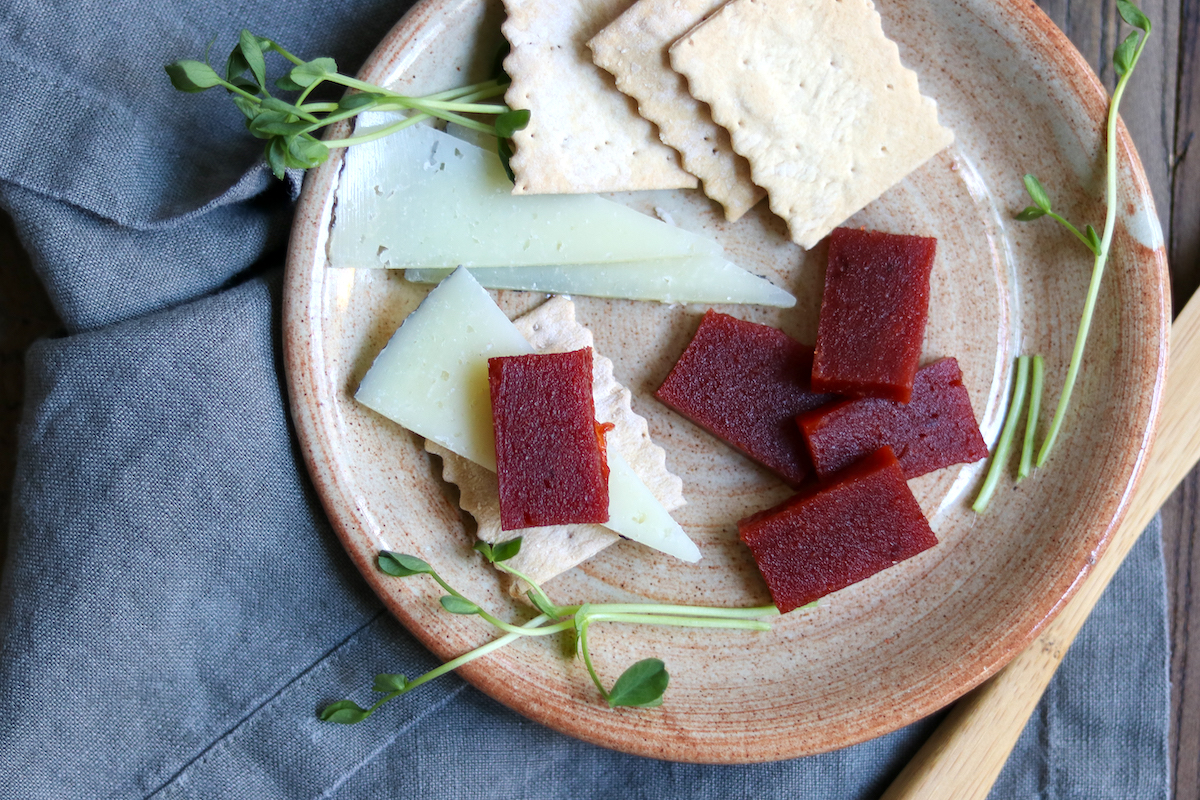
Quince paste is somewhat of a pantry staple in many Mediterranean, South American, and European cuisines, but it’s still a relatively obscure condiment in the United States. If you’re unfamiliar with quince paste, I’m here to tell you how fabulous and versatile this beautifully flavored condiment is. If you’re already a fan of quince paste, I’m going to show you how easy it is to make from scratch.
Quinces look like a cross between apples and pears, which makes sense because they’re in the same family, but are largely inedible raw—the taste can only be described as sour, astringent, and woody.
Once cooked, they completely transform into something wonderful.
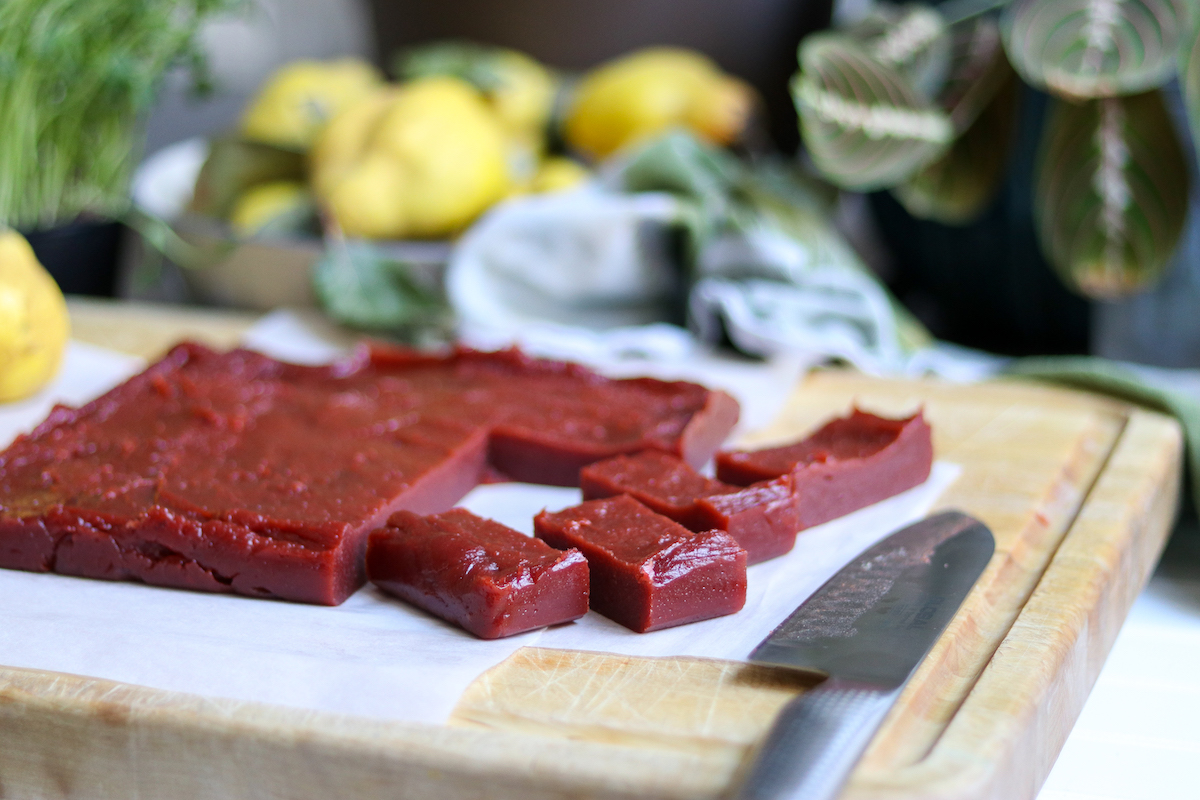
Cooked quince, on the other hand, has a lovely tangy flavor that gets sweeter the longer it’s cooked, reminding me of the aforementioned apples and pears, as well as guava and gorgeous floral notes.
When quince paste is thinly sliced and arranged on a cheese board the results are nothing short of spectacular. I like to pair it with Mediterranean staples such as aged Manchego or Iberico cheese, briny olives, thinly sliced charcuterie, crackers, or crusty bread.
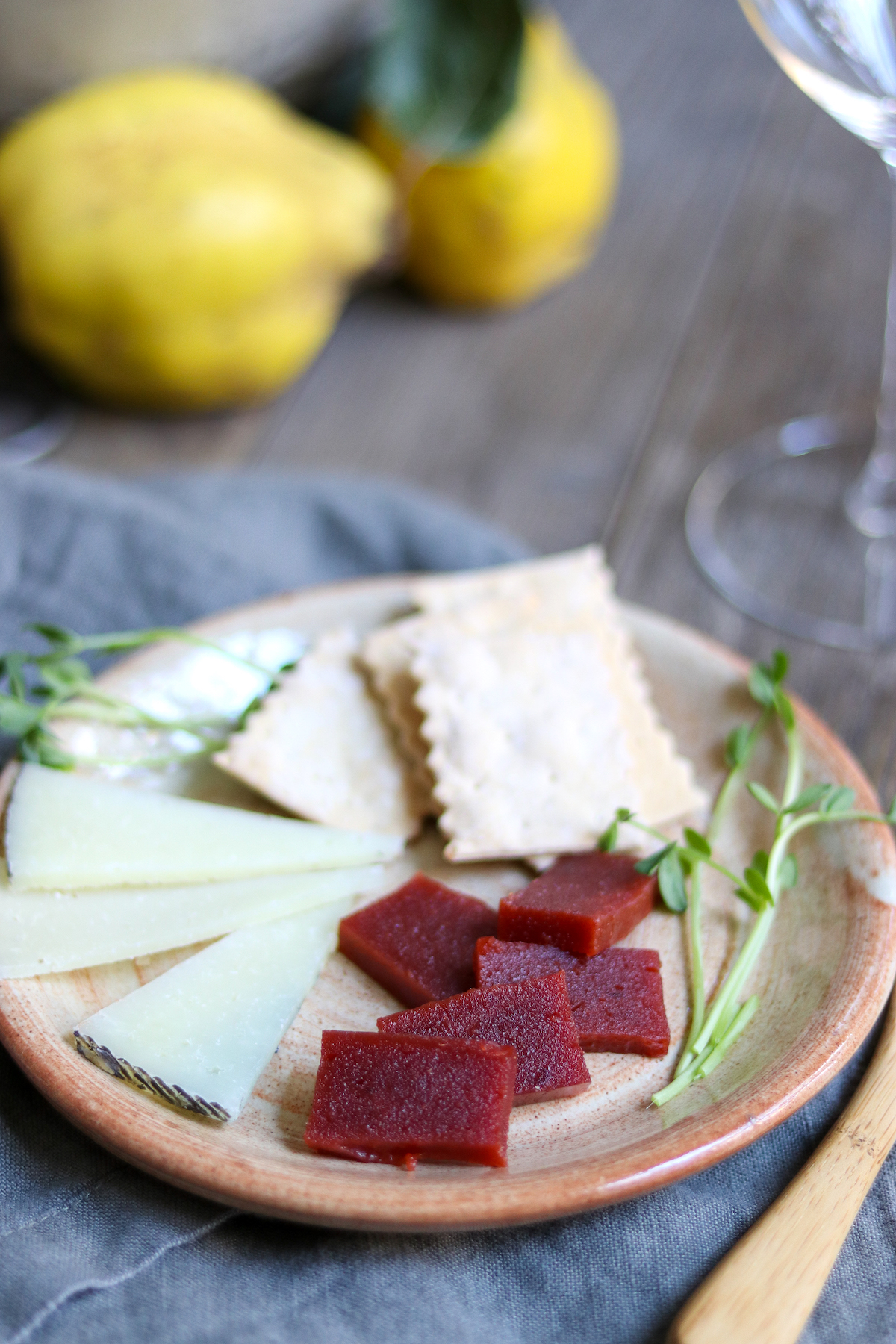
If you’re feeling generous and would like to spread the word on quince, this recipe is perfect for portioning off and gifting to lucky friends and family. I wouldn’t blame you, however, if you decided to keep the entire yield to yourself.
What is Quince Paste?
Quince paste goes by many names, including quince cheese, membrillo (Spanish quince paste), marmelada (Portuguese quince paste), and codonyat (Catalan quince paste). Despite its many names, the basic recipe remains similar across many cultures all over the world.
In most recipes for quince paste, the fruit is cooked until soft; is then puréed and combined with a sweetener, lemon juice, and the poaching liquid; and then cooked until it has been reduced to a thick paste which is then cooled until it becomes solid.
Quince paste is traditionally served cheese, charcuterie, on toast or tucked into sandwiches, rolled into pastries, or added to cakes and other desserts.
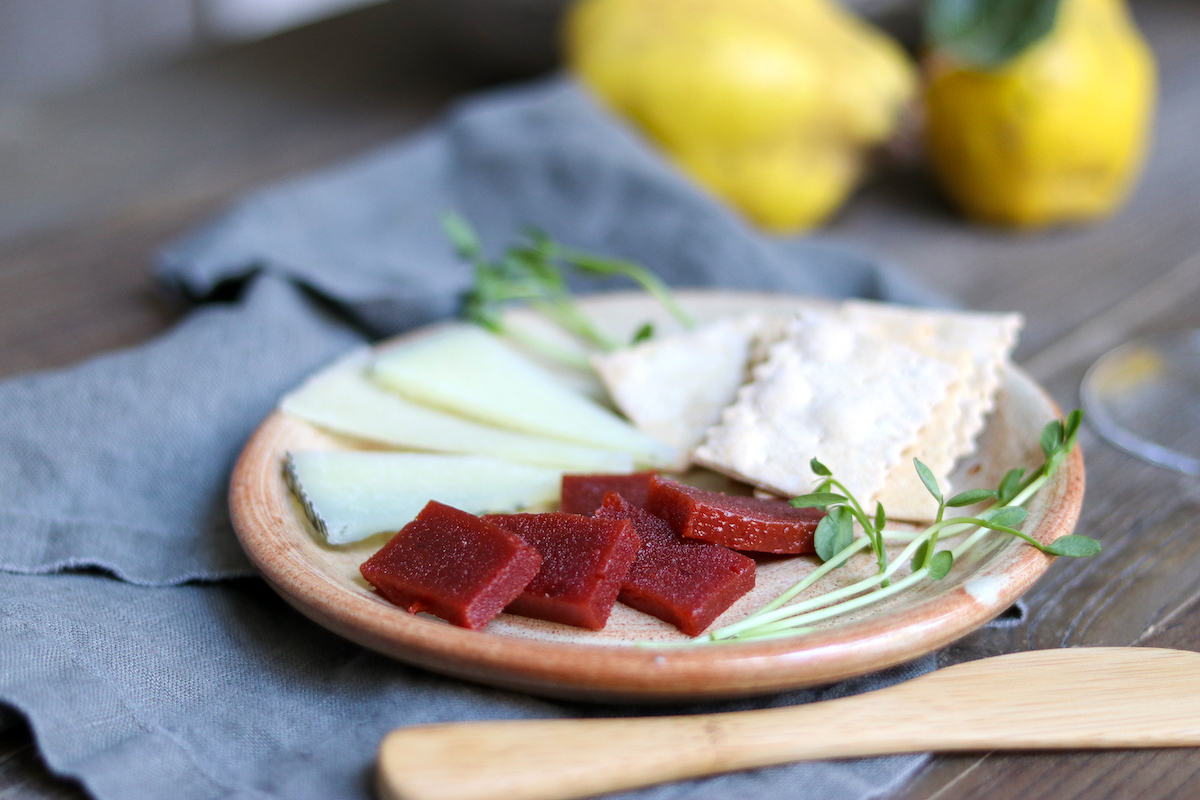
Ingredients for Quince Paste
The list of ingredients needed to make homemade membrillo or quince paste is incredibly straightforward. Beyond quinces, the only other ingredients are sugar and lemon juice (plus water for cooking the quince). For this recipe, you’ll need 3 1/2 pounds of quinces, an amount that will yield about 3 pounds of quince paste which is then spread across an 8×8-inch baking pan.
I recommend weighing out the quinces using a kitchen scale instead of relying on a rough estimation, as there can be quite a variability in size with each fruit. For this recipe, the weight is measured before the fruit is cored and quartered.
You won’t need any special equipment to make quince paste, either. For this recipe, you’ll need:
- a Dutch oven
- parchment paper
- kitchen shears (to cut the parchment paper)
- a colander
- a food processor
- a fine-mesh strainer
- a medium-sized bowl
- an 8-inch square baking pan
- a spatula
You’ll also want to have a sharp chef’s knife for preparing the fruit and for cutting the prepared quince paste into portions once it’s set.
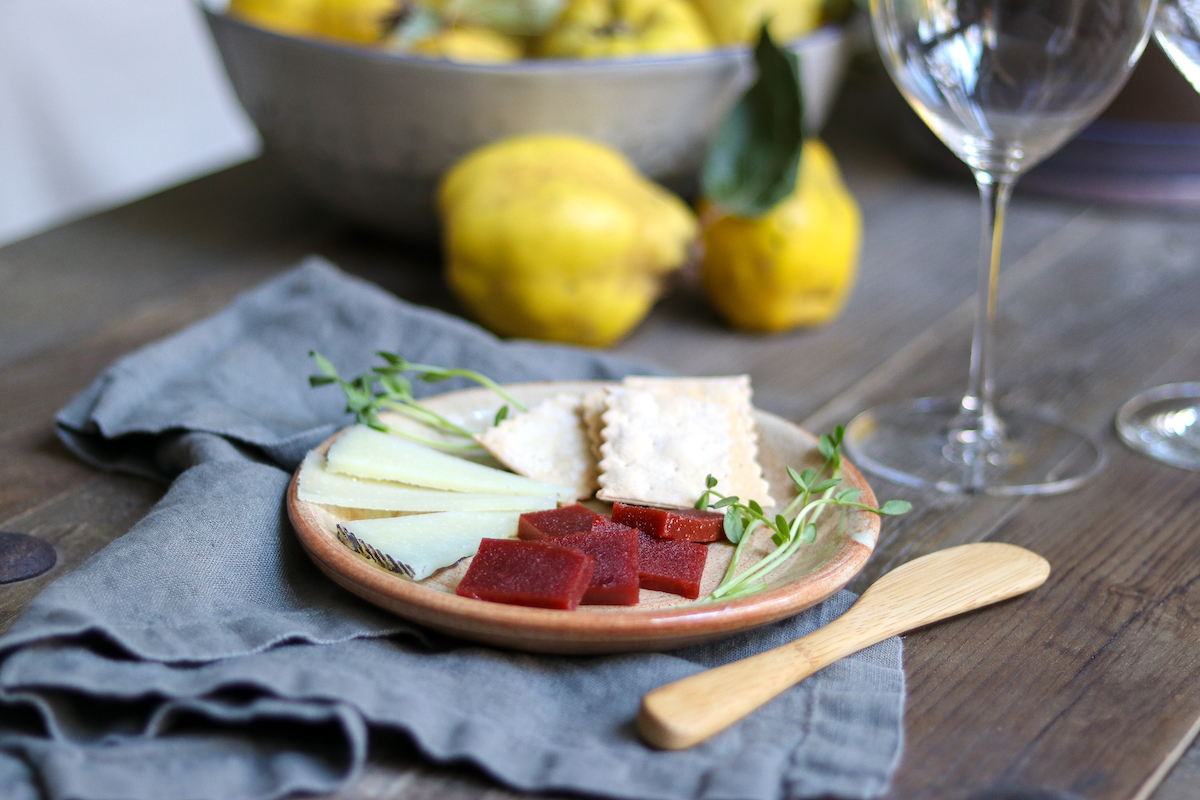
How to Make Quince Paste
The first step when you’re making quince paste is to prepare the fruit for cooking. Since the cut-up quince will be processed in a food processor and then pushed through a fine-mesh sieve, you don’t have to worry about peeling the fruit beforehand.
Quince is notoriously fibrous with a texture that’s simultaneously woody and spongy. When quartering and coring quince, a sharp chef’s knife is imperative for safety reasons as well as efficiency.
As you work, keep an eye out for black spots or blemishes (also known as fruit knots). You can remove these with your chef’s knife or with a paring knife.

Quinces are like apples and pears in that they’ll begin to brown fairly quickly once exposed to air. This isn’t anything to worry about and has no effect on taste or the appearance of the finished quince paste.
The next step is to create a parchment paper “lid” for your Dutch oven:
Using a large sheet of parchment paper, trace the outline of the Dutch oven. We’re going to rest the parchment paper on the surface of the cooking liquid to keep the quince submerged.
Be sure to cut inside the traced line, otherwise the parchment will be too big for the cooking vessel. If you’re having trouble keeping the parchment paper lying flat, crumple it into a tight ball, then smooth it flat again.
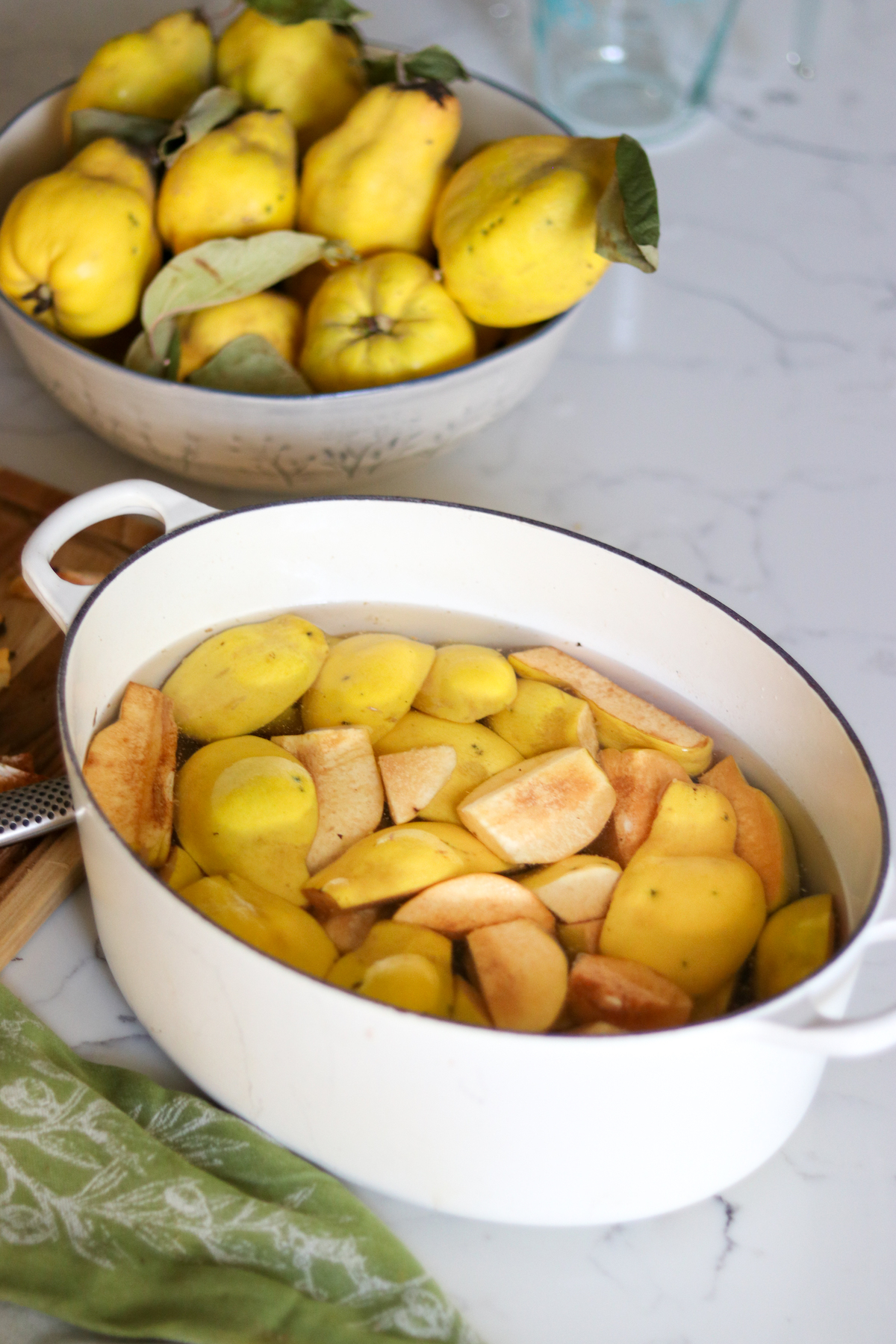
Add the quartered and cored quinces to the Dutch oven and cover with 8 cups of water, placing the parchment paper over the top.
Bring the liquid to a boil over high heat and cook the fruit for about 1 1/2 hours. The goal is to be able to easily pierce the quince with a knife.
Once the quinces are knife-tender, pour the contents of the Dutch oven into a colander set over a large bowl. You should have about 5 cups of reserved cooking liquid left over.
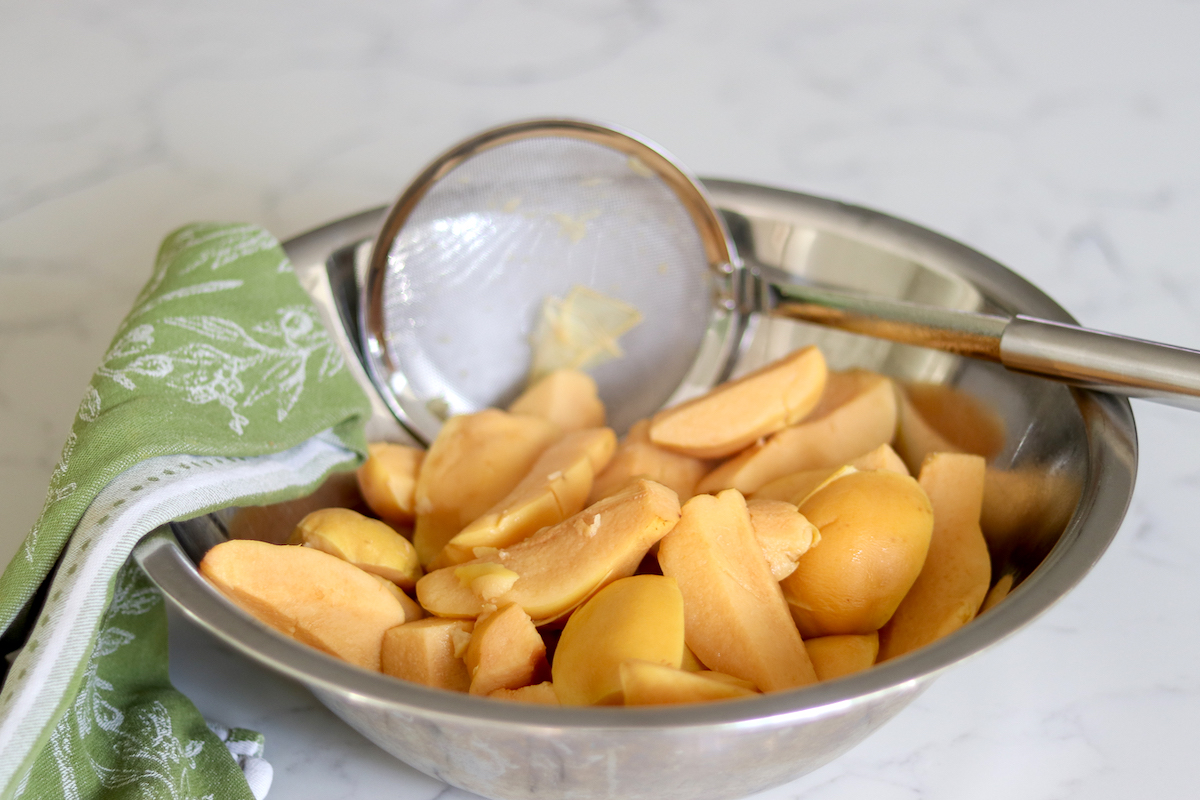
Pour the liquid back into the empty Dutch oven and reduce the liquid (uncovered) to about 3 cups over medium-high heat, this usually takes about 15 minutes.
While the cooking liquid is reducing, carefully transfer the cooked quinces to a food processor (they will still be quite hot!).
Process the fruit for about 45 seconds to a full minute, scraping down the sides of the bowl as needed. You’re aiming for a very smooth texture without any lumps.
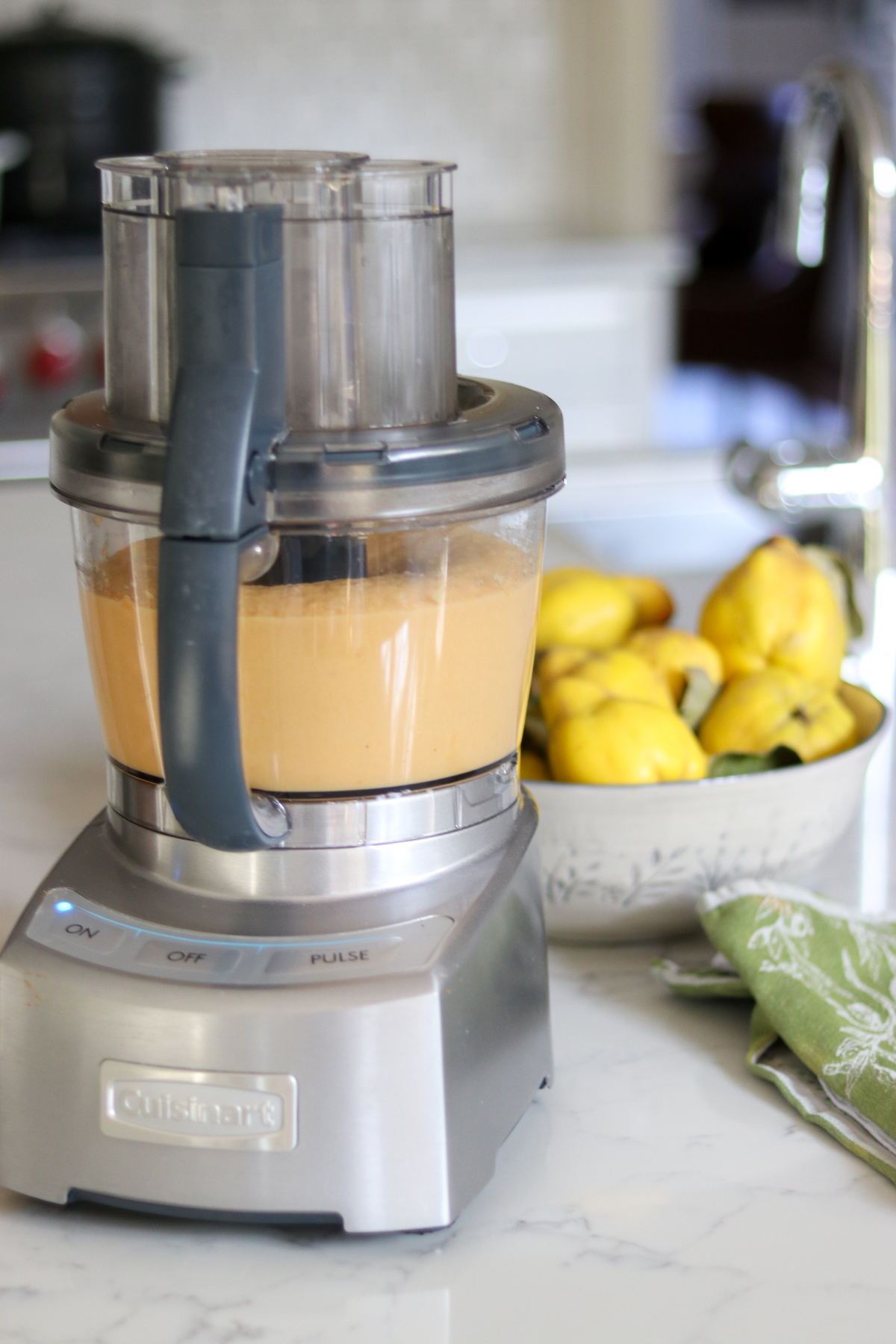
Set a fine mesh sieve over a medium-sized bowl and press the quince purée through the sieve into the bowl. Work in small batches during this step, using a spatula to help move the fruit through the sieve.
When you’re done, you should be left with roughly 4 cups of silky quince purée; discard any of the remaining solids.
Next, we’re going to preheat the oven to 350° F. Before you turn on the heat, move the oven rack to the middle.
Grease your 8×8-inch baking pan and line with parchment paper. Again, try using the crumple method if you’re struggling to get the parchment paper to lay flat. Metal binder clips are also useful to keep the parchment paper in place.
Using a spatula, pour the quince purée back into the Dutch oven with the reserved cooking liquid.
Stir in 4 cups of sugar and the juice of 2 lemons (or 1/4 cup bottled lemon juice) and 4 cups of granulated sugar. Bring the mixture to a boil over medium-high heat.

Once the quince mixture reaches a boil, reduce the heat to medium-low and let it simmer, occasionally stirring with a spatula. As it cooks, it will begin to thicken, and the color will darken.
This stage will take about 30 minutes, as it comes to an end the quince mixture will start to splatter and make sputtering sounds—you’ll need to stir it more often at this point to prevent burning.

Remove the Dutch oven from the heat and transfer to the preheated oven, placing it on the middle rack. Cook for about 1 to 1 1/2 hours, the goal is to have the quince turn a beautiful shade of plum red. It will continue to thicken until it reached a more paste-like consistency.
As it cooks, continue to stir the mixture every 15 minutes, carefully scraping down the sides of the Dutch oven to encourage even cooking and to prevent accidental burning.
As you can see in the picture above, when the mixture has finished cooking you’ll be able to “trace” the spatula so that the bottom of the Dutch oven is visible (I like to call this a Red Sea parting effect).
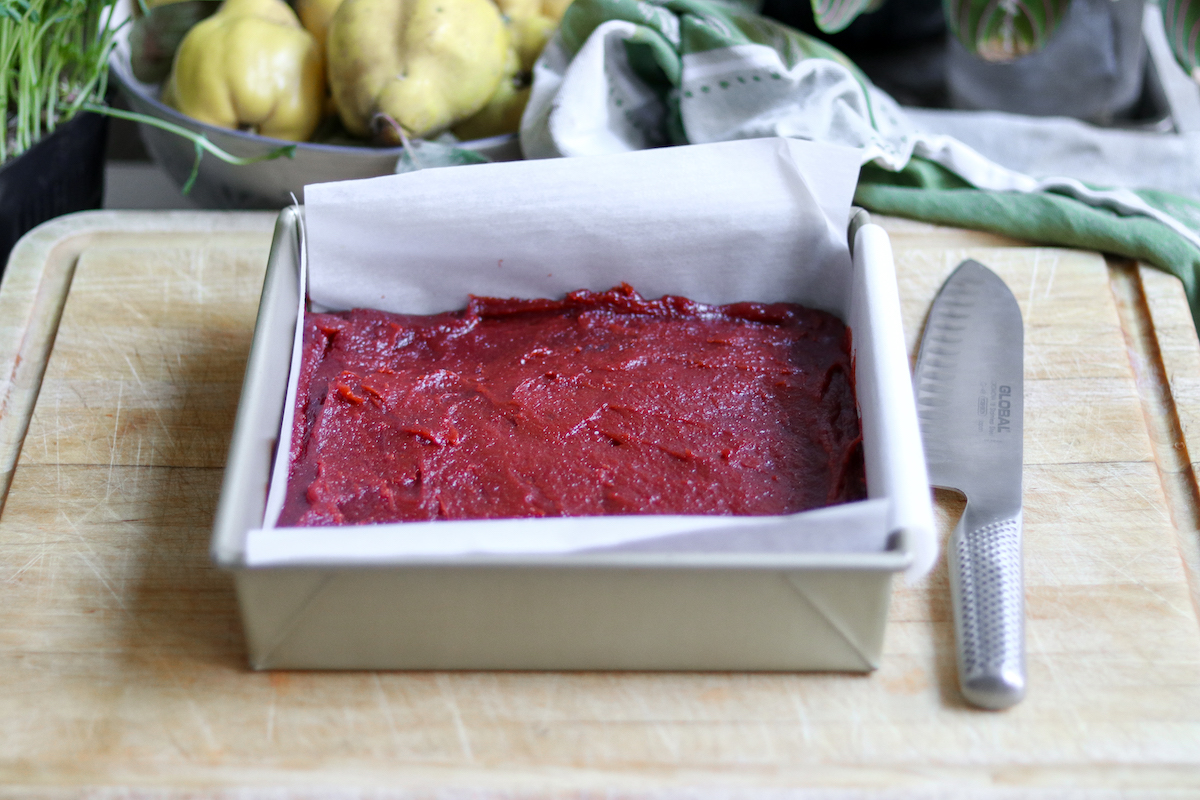
When the quince mixture has finished cooking, carefully scrape it into the prepared parchment-lined 8×8-inch baking pan. Smooth the top using a spatula and let the paste come to room temperature.
When the paste has come to room temperature, transfer the baking pan to the refrigerator and chill for at least 4 hours until completely set.
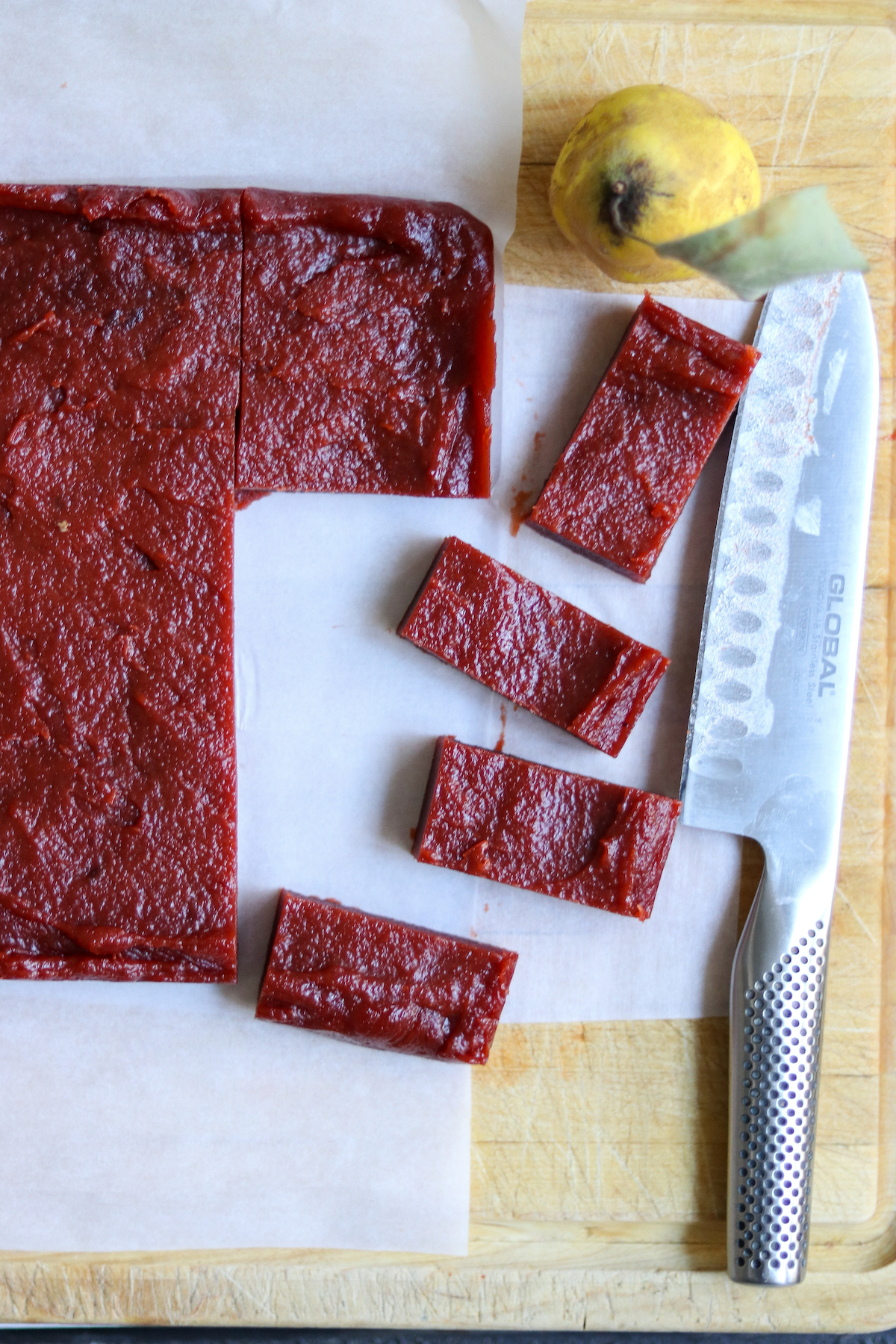
Once the quince paste is firm, remove the baking pan from the fridge. Prepare a cutting board, making sure it won’t slip as you cut up the quince paste.
If you have a wobbly cutting board, wet a kitchen towel and place it under the board—this will prevent it from slipping as you work. The paste will be quite sticky so I always like to make sure I have a stable cutting surface.
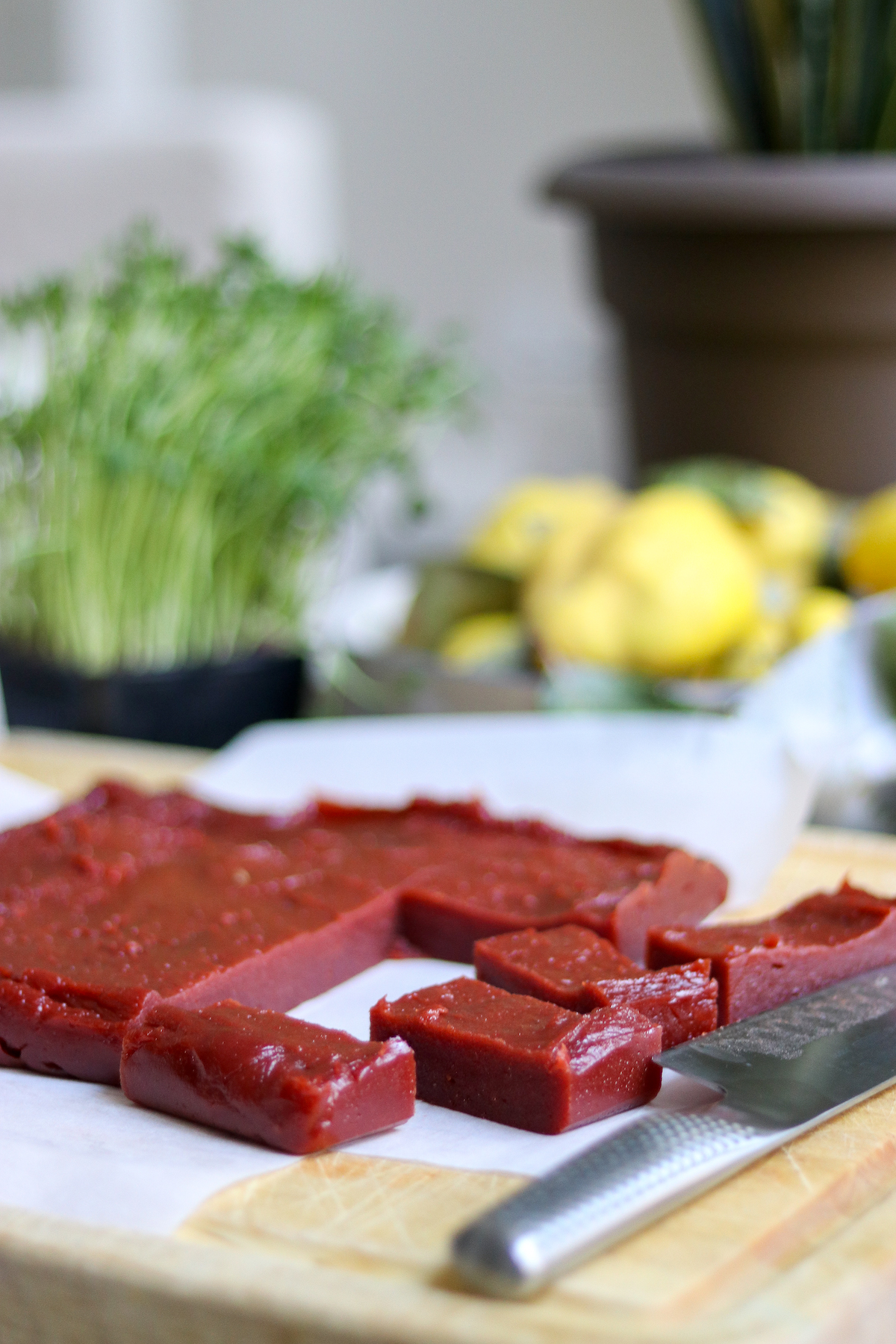
Invert the cold baking pan over the cutting board—you can use a butter knife to wiggle the parchment out if there’s any stickiness preventing the paste from popping right out.
The next step is to cut your homemade membrillo quince paste into smaller portions.
I’ll leave the size up to you, but I like to slice the quince paste into small rectangles.
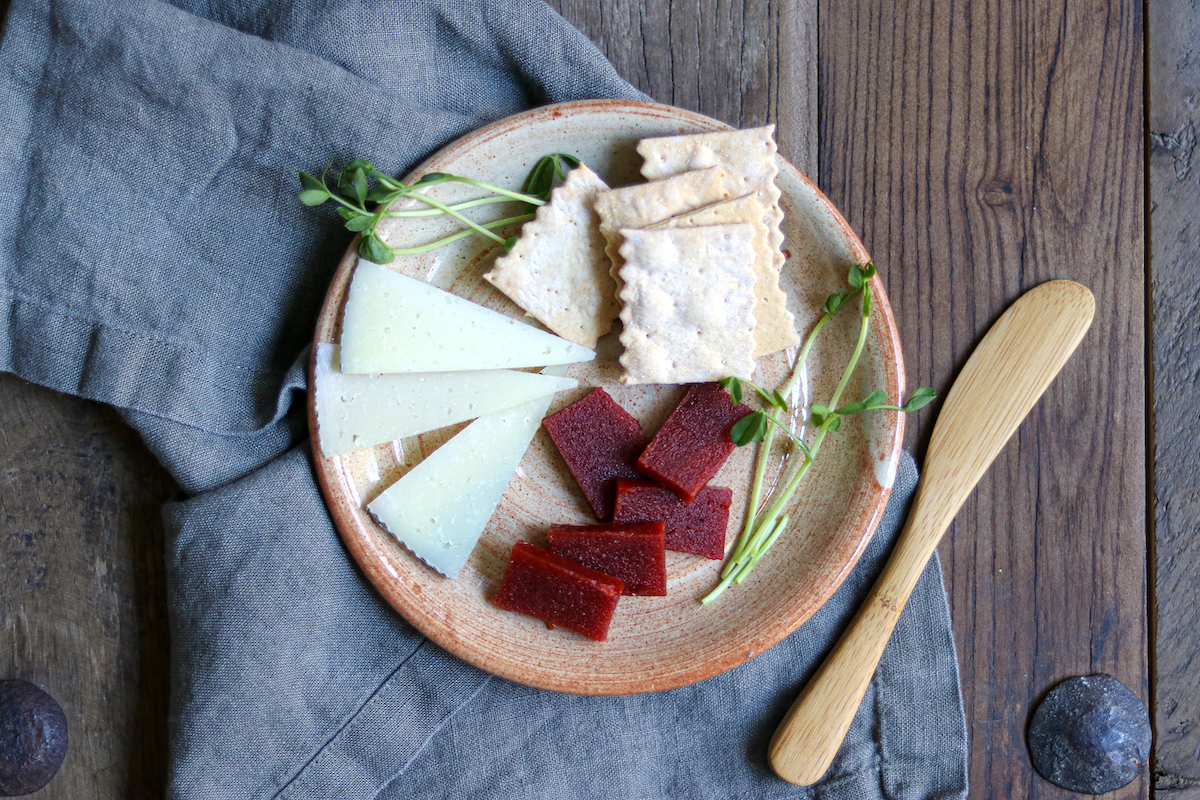
Because the quince paste is quite sticky, I recommend using a sharp chef’s knife with some weight—running it under cold water between each cut makes the cutting easier.
Once the quince paste has been cut into the desired portion sizes, it’s time to wrap them for storage or for gift-giving. If the quince paste is for personal use, I like to wrap each piece in parchment before storing in the fridge.
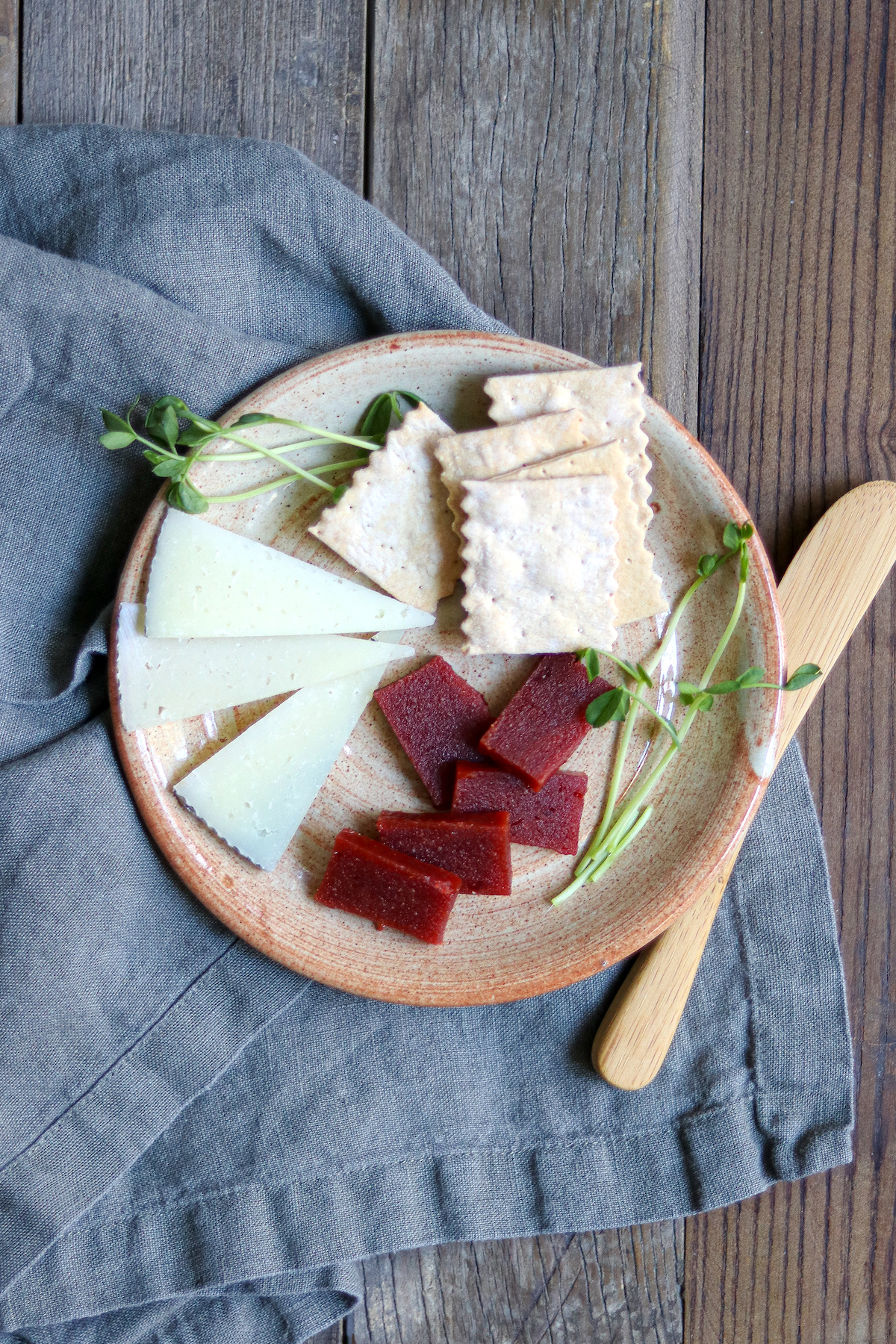
If I plan on storing it long-term (longer than a month) I will also wrap it in a tight layer of plastic wrap. When quince paste is double-wrapped with parchment and plastic wrap it will keep for up to 6 months in the fridge.
To give quince paste as a gift, I’ll simply wrap it in parchment paper and secure it with twine—I’ll also include a little note highlighting how it should be served and my favorite ways to pair it with cheese and charcuterie.
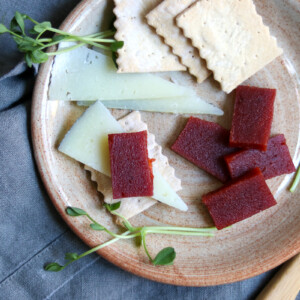
Quince Paste
Ingredients
- 3 1/2 lbs. quinces, cored and quartered
- 8 cups water
- 4 cups granulated sugar
- 1/4 cup lemon juice, bottled or juice of 2 lemons
Instructions
- Add prepared quinces and water to a large Dutch oven. Cover the surface with a piece of parchment paper that has been cut to fit.
- Bring the water to a boil over medium-high heat. When the water starts to boil, reduce heat to medium-low and simmer for 1 1/2 hours or until the quinces can be easily pierced with a knife.
- Place a colander over a large bowl and drain the quinces, reserving the cooking liquid (there should be about 5 cups)
- Transfer the cooking liquid back to the Dutch oven. Bring the liquid to a boil and reduce to 3 cups (this will take about 15 minutes).
- While the cooking liquid is reducing, blitz the cooked quinces in a food processor until very smooth.
- Place a fine-mesh sieve over a bowl and press the puréed quinces through the sieve into the bowl. Work in small batches during this step, you should be left with 4 cups of silky quince purée. Discard the remaining solids.
- Preheat oven to 350° F. Position oven wrack in the middle.
- Grease 8x8-inch baking pan and line with parchment paper.
- Pour quince purée back into the Dutch oven with the reduced cooking liquid. Add sugar and lemon juice, stir. Bring mixture to a boil.
- Reduce heat to medium-low and simmer, stirring occasionally. After about 30 minutes, the mixture will have thickened and darkened in color.
- Move the Dutch oven into the oven, placing it on the middle rack.
- Cook the quince mixture for 1-1 1/2 hours, stirring and scraping the sides every 15 minutes. The finished quince paste will have thickened significantly and will have turned a vivid shade of plum red.
- Using a spatula, carefully scrape the thickened quince paste into the prepared baking pan. Let it come to room temperature.
- Transfer the quince paste to the fridge and let it set for at least 4 hours.
- Flip the baking pan and its contents onto a cutting board, and remove the parchment paper.
- Using a sharp chef's knife, cut the quince paste into smaller portions.
- Wrap each slice in parchment paper and an outer layer of plastic wrap.
- Store wrapped-up quince in the fridge for up to 6 months.
Quince Recipes
Looking for more ways to use Quince?
Ways to Preserve Fruit
Quince isn’t the only fruit in season this time of year!
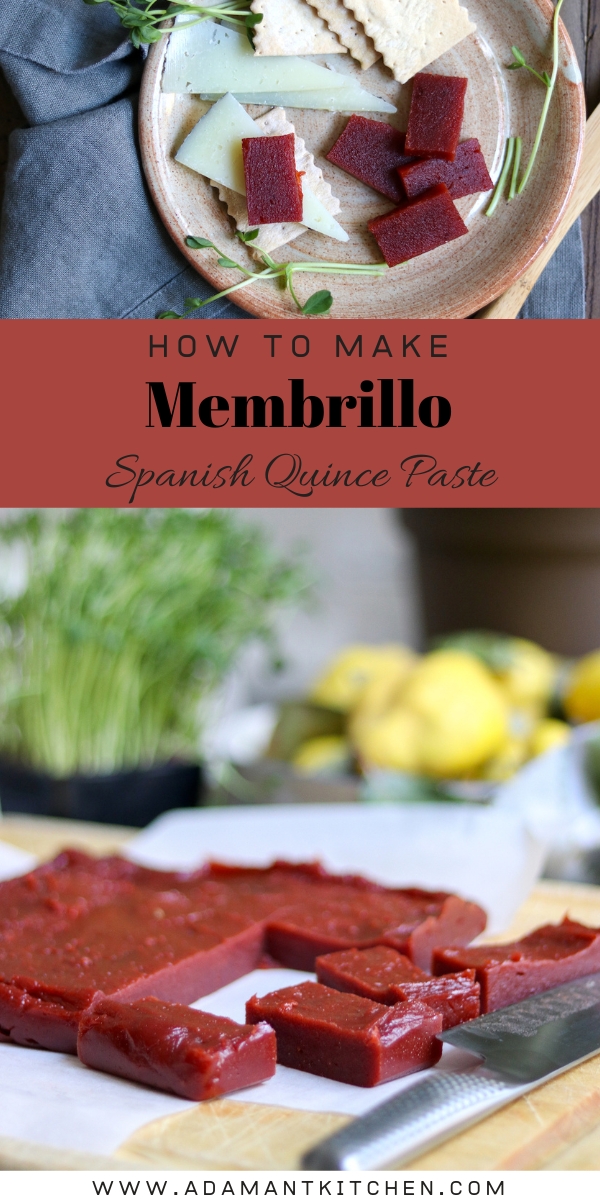

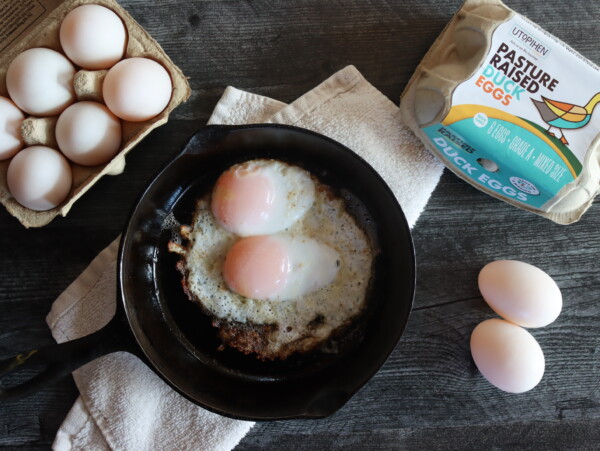
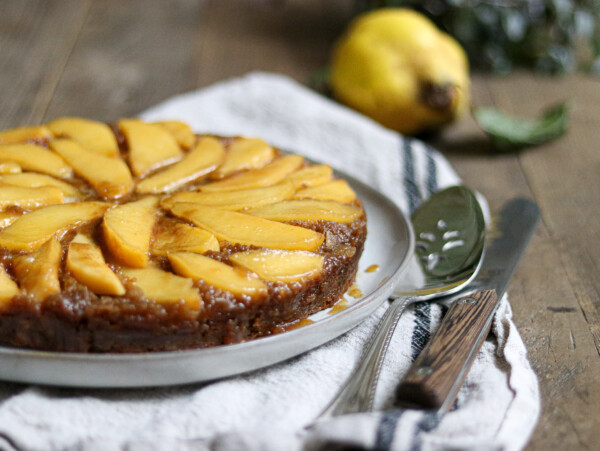
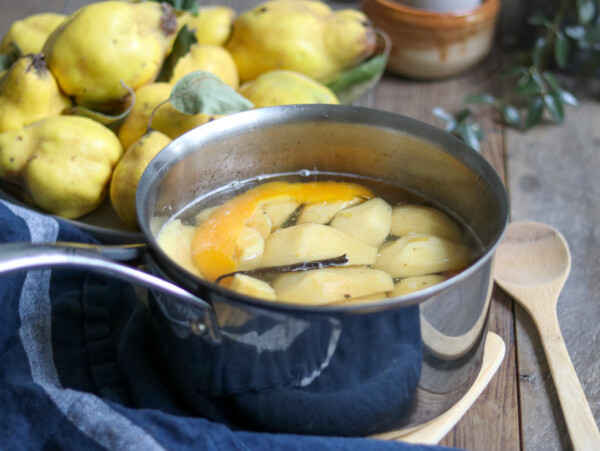
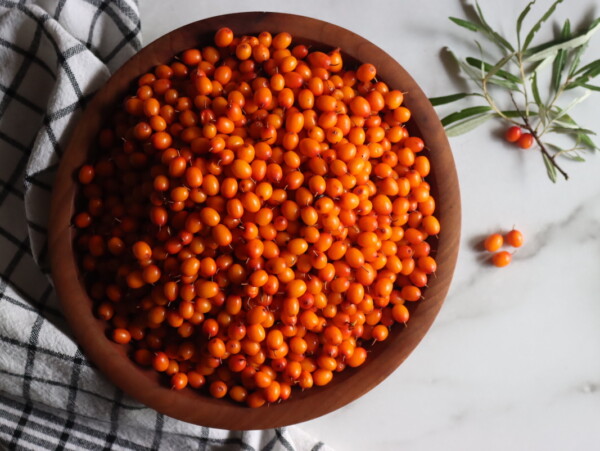
1 Comment